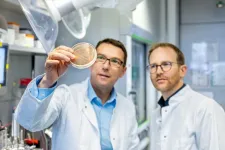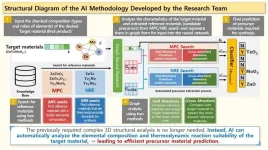Tumor organoids, i.e. mini-tumors grown from surgical material in the culture dish, are now widely used in cancer research. Numerous research groups have already developed approaches to cultivate brain tumors in the laboratory, especially for the very aggressive glioblastomas. However, the complexity of the tumors is a major challenge for this research. In many of the existing methods, the mini-tumors quickly lose important properties or the interactions between tumor cells and their environment cannot be adequately represented.
The new model from Haikun Liu, DKFZ, relies on cerebral organoids – a type of “mini-brain” generated from induced human pluripotent stem cells. In these organoids, which exhibit brain-like properties, the researchers grow freshly collected tumor samples. This creates a model of the tumor that accurately mimics the diversity of cell types, the complex tumor environment, and the molecular characteristics of the original tumor. The researchers named the new method IPTO (Individualized Patient Tumor Organoid). This method was tested in patient samples from hospitals in Heidelberg, Mannheim and further validated in a large number brain tumor patients in Shanghai in collaboration with ShanghaiTech University.
“With IPTOs, we can not only maintain the structure and heterogeneity of the tumors, but also predict their response to different therapies,” explains study leader Haikun Liu. What makes this method so special is that it can be applied to a wide range of tumors of the central nervous system, from aggressive brain tumors such as glioblastomas to brain metastases, which occur in about 20 percent of all cancer patients. In the current study, the team cultured IPTOs from up to 48 tumor entities including pediatric brain tumors, different forms of glioblastoma, and breast, lung or colon cancer brain metastases.
“We hypothesize that the communication between neurons and cancer cells in the IPTO model favors the growth of central nervous system tumors, reflecting recent developments in cancer neuroscience,” Liu explains.
The researchers found the IPTO model to be particularly useful for testing the efficacy of chemotherapy or other anti-cancer drugs on individual tumors. In a prospective study of 35 glioblastoma patients, the IPTOs were able to accurately predict the response to the important drug temozolomide. This marks IPTO the first brain tumor preclinical model that predicts patient response in prospective clinic setting. In experiments with IPTOs grown from brain metastases, the mini-tumors in the culture dish also accurately reflected the therapy results with targeted drugs – a decisive step towards personalized medicine. Since the amount of immune cells also matches between IPTOs and their parent tumors, the mini-tumors are already being tested for their suitability to predict the effectiveness of immunotherapies.
“We are very excited that doctors from many different countries already approached us to explore how to use the IPTO model to find the best treatment options for their patients more quickly and reliably,” says stem cell expert Liu, who has just founded a DKFZ spin-off with his colleagues to further explore the potential of IPTOs for drug testing, the team will collect the high quality molecular data from the drug treatment and use this data for training advanced artificial intelligence models which may help find the best treatment for brain cancer patients. However, the method still needs to be evaluated further before it can be used in patient care.
Publication
Tianping Peng, Xiujian Ma, Wei Hua, Changwen Wang, Youjun Chu, Meng Sun, Valentina Fermi, Stefan Hamelmann, Katharina Lindner, Chunxuan Shao, Julia Zaman, Weili Tian, Yue Zhuo, Yassin Harim, Nadja Stöffler, Linda Hammann, Qungen Xiao, Xiaoliang Jin, Rolf Warta, Catharina Lotsch, Xuran Zhuang, Yuan Feng, Minjie Fu, Xin Zhang, Jinsen Zhang, Hao Xu, Fufang Qiu, Liqian Xie, Yi Zhang, Wei Zhu, Zunguo Du, Lorena Salgueiro, Mark Schneider, Florian Eichhorn, Arthur Lefevre, Stefan Pusch, Valery Grinevich, Miriam Ratliff, Sonja Loges, Lukas Bunse, Felix Sahm, Yangfei Xiang, Andreas Unterberg, Andreas von Deimling, Michael Platten, Christel Herold-Mende, Yonghe Wu, Hai-Kun Liu, Ying Mao: Individualized patient tumor organoids faithfully preserve human brain tumor ecosystems and predict patient response to therapy.
Cell Stem Cell 2025, DOI: 10.1016/j.stem.2025.01.002
A picture of an IPTO is available for download:
IPTO.jpg (1677×1440)
BU: Microphotography of an IPTO: the brain organoid grown from pluripotent stem cells is shown in green, the cells of the mini-tumor are stained red.
Note on use of images related to press releases
Use is free of charge. The German Cancer Research Center (Deutsches Krebsforschungszentrum, DKFZ) permits one-time use in the context of reporting about the topic covered in the press release. Images have to be cited as follows: “Source: Liu/DKFZ”.
Distribution of images to third parties is not permitted unless prior consent has been obtained from DKFZ’s Press Office (phone: ++49-(0)6221 42 2854, E-mail: presse@dkfz.de). Any commercial use is prohibited.
With more than 3,000 employees, the German Cancer Research Center (Deutsches Krebsforschungszentrum, DKFZ) is Germany’s largest biomedical research institute. DKFZ scientists identify cancer risk factors, investigate how cancer progresses and develop new cancer prevention strategies. They are also developing new methods to diagnose tumors more precisely and treat cancer patients more successfully. The DKFZ's Cancer Information Service (KID) provides patients, interested citizens and experts with individual answers to questions relating to cancer.
To transfer promising approaches from cancer research to the clinic and thus improve the prognosis of cancer patients, the DKFZ cooperates with excellent research institutions and university hospitals throughout Germany:
National Center for Tumor Diseases (NCT, 6 sites)
German Cancer Consortium (DKTK, 8 sites)
Hopp Children's Cancer Center (KiTZ) Heidelberg
Helmholtz Institute for Translational Oncology (HI-TRON Mainz) - A Helmholtz Institute of the DKFZ
DKFZ-Hector Cancer Institute at the University Medical Center Mannheim
National Cancer Prevention Center (jointly with German Cancer Aid)
The DKFZ is 90 percent financed by the Federal Ministry of Education and Research and 10 percent by the state of Baden-Württemberg. The DKFZ is a member of the Helmholtz Association of German Research Centers.
Contact:
Dr. Sibylle Kohlstädt
Strategic Communication and Public Relations
German Cancer Research Center
Im Neuenheimer Feld 280
D-69120 Heidelberg
T: +49 6221 42 2843
Email: presse@dkfz.de
END




